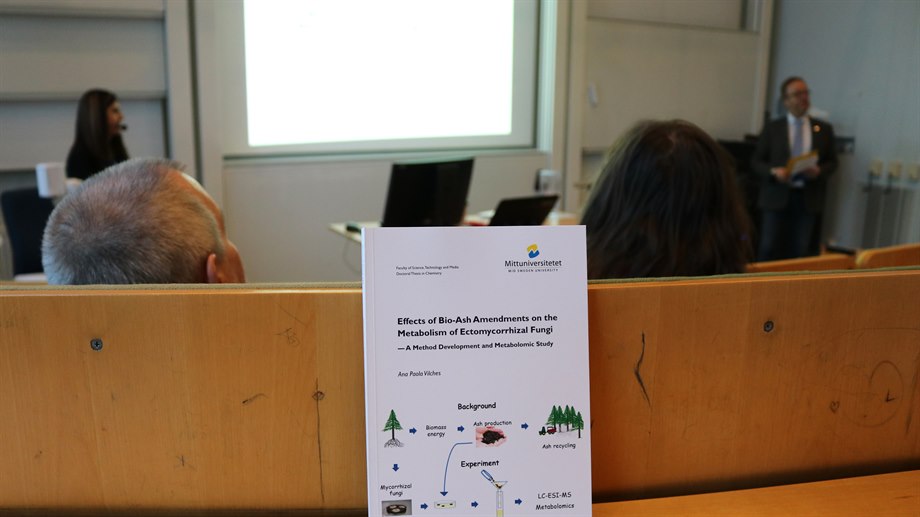av
Defence of a Doctoral Thesis with Ana‑Paola Vilches
Ana-Paola Vilches defended her Doctoral Thesis in Chemistry today. And she got approved. Congratulations Ana-Paola!
Supervisor
Professor Dan Bylund
Co-Supervisor
Dr Sara Norström
External reviewer
Assoc. Prof. Bjarne W. Strobel
Department of Plant and Environmental Sciences
University of Copenhagen, Denmark
Examining committee
Anke Herrmann
Per Sjöberg
Roger Finlay
Abstract
Forest ecosystems have played a fundamental role in the development of our society. Since the beginning of the civilization, forest have provided us with wood as a product for construction, tools, furniture and domestic heating. The well-being of the forest is therefore fundamental to our existence. Today, our growing societies have increased energy needs; the resulting depletion of fossil reserves and the effects of their use has again shown how the forest is among the most important alternatives for sustainability of our ecosystem. In order to responsibly make this resource a key part of our energy and material supply, we need to understand how forestry practices influence the different processes taking place in the forest ecosystems.
The use of raw material from forest as energy source produces huge amounts of ash. The ash contains the base cations that have once been translocated from soil to the upper parts of the trees. Ash recycling has therefore been suggested as a measure to counteract soil acidification due to extensive harvest. Since spreading of ash can have great effects on the forest, it is important to understand which these effects are and how big they might be.
This thesis focuses on the effects that such an ash recycling may have on the metabolism of ectomycorrhizal fungi; that is, fungi that are able to colonize root of trees, and contribute to the acquisition of nutrients and water from soil. The work presented here utilized an in vitro metabolomic approach on eight species of ectomycorrhizal fungi normally found in boreal forests. A targeted metabolomic study addressed the effects of ash amendments on growth, external pH and the exudation of low molecular mass organic acids, amino acids and hydroxamate siderophores. This was complemented by an untargeted metabolomic study to address the effects of ash amendment on the general metabolism of the fungal species.
Analyses were performed with well-established chemical methods, and some that had to be developed specifically for this thesis work. A method for the analysis of amino acids without derivatization and yet compatible with mass spectrometry had to be developed and validated. The result was a robust method that works well with external calibration, shows good long-term stability, relatively low detections limits and high sample throughput. A screening protocol for the determination of siderophores from mass spectrometry data was also established.
The metabolomic studies showed that bio-ash amendment increased the exudation of low molecular mass organic compounds from all the studied species. This means that the species tended to exude more of the same compounds compared to the controls without ash. In some cases, the bio-ash also triggered the exudation of new compounds. There was some exceptions, though; bio-ash amendment had negative effects on the exudation of certain metabolites, but these negative effects were of lower magnitude compared to the positive effects.
Both metabolomics studies showed a differentiation between the ascomycetes and the basidiomycetes species. The targeted metabolomic study, indicated a trade-off in the utilization of carbon for accumulation of biomass or for the exudation of low molecular mass organic compounds, in which the ascomycetes accumulated more carbon as biomass compared to the basidiomycetes. According to the untargeted metabolomic study, the ascomycetes species presented the greatest number of metabolites that were influenced significantly by ash treatment, either as increase or decrease.
Adding extracted ash to the culturing medium at the beginning of the experiment increased the pH, but this was counteracted by species metabolism as exudation of organic acids correlated with a drop in external pH. Ash treatment triggered the total exudation of low molecular mass organic acids in five of the eight studied species and especially in Cortinarius glaucopus. Ash treatment also triggered the exudation of amino acids from Tomentellopsis submollis and ferricrocin from Hymenoscyphus ericae.
Of note was that no metabolite significantly influenced by ash was found to be common to all species, indicating that the ash amendments mainly affected the secondary metabolism under the culturing conditions used. Additionally, the ascomycetes Hymenoscyphus ericae exuded the greatest number of metabolites affected by ash that were exuded only by a single species. Conversely, Piloderma olivaceum exuded the largest number of unique metabolites not influenced by ash.










